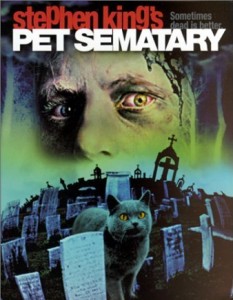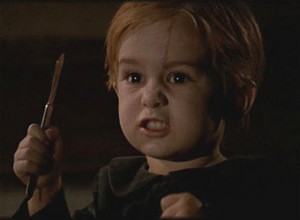 One of the programs I watch every time it’s replayed is Bravo’s “The 100 Scariest Movie Moments” (2004). Although I certainly find my areas of disagreement in the program’s selection of moments (for example, Jaws listed as number 1, the flying monkeys from The Wizard of Oz being included, and inclusion of the psychedelic boat scene from Willy Wonka & the Chocolate Factory), it includes clips from films I’ve never seen and therefore opens up new opportunities for horror viewing. Last year I tracked down one of these films, Pet Sematary (1989), due to an intriguing clip and with this post I’ll provide some commentary on why I think this film presents a particularly horrific situation for certain viewers.
One of the programs I watch every time it’s replayed is Bravo’s “The 100 Scariest Movie Moments” (2004). Although I certainly find my areas of disagreement in the program’s selection of moments (for example, Jaws listed as number 1, the flying monkeys from The Wizard of Oz being included, and inclusion of the psychedelic boat scene from Willy Wonka & the Chocolate Factory), it includes clips from films I’ve never seen and therefore opens up new opportunities for horror viewing. Last year I tracked down one of these films, Pet Sematary (1989), due to an intriguing clip and with this post I’ll provide some commentary on why I think this film presents a particularly horrific situation for certain viewers.
Pet Sematary is one of several transformations of Stephen King stories into films, and while this usually results in a disappointment for fans of King’s work, it may not be the case in this instance. I derive my enjoyment from horror through film and television rather than reading (due to personal preferences) so this wasn’t an issue for me, but the film’s narrative thread in its treatment of the vanquishing of death, whether a faithful translation of King’s work or merely a good faith attempt at finding inspiration from it, hits appropriate buttons of fear, particularly, I believe, for certain segments of its audience.
Pet Sematary presents the story of the Creed family who have just moved into a new neighborhood. Their new home includes two interesting features, the first being a very busy road frequented by lots of traffic, including semi trucks, and a pet cemetery near an Indian burial ground purported to have magical powers in the form of resurrection. As the story unfolds the family loses their pet cat, and after a burial in the “pet sematary” it returns from beyond, only with significantly negative changes in behavior and appearance. A little later the family experiences a great tragedy when their young son Gage wanders onto the busy road while chasing a kite string, only to meet his death after being run over by a truck. The family is understandably grief stricken, and as a result the father makes the decision to dig up Gage from his formal burial place for reburial in the Indian burial ground. Gage rises from the grave, but like the family cat, he comes back distorted and evil as he begins to attack and murder neighbors and family alike.
 In my view this film is a good horror film which presents genuinely frightening aspects in two particular areas. First, is the way in which the film presents a sour note on what should be a great triumpth in the conquering of death. It does so by addressing the desire for return from death, but raises an even greater fear about what would happen if death were conquered but then resulted in a “post-resurrection” form that is evil as a distortion of one’s previous character. Pet Sematary then magnifies this fear as this post-mortem situation is played out in the particular character brought back from the dead.
In my view this film is a good horror film which presents genuinely frightening aspects in two particular areas. First, is the way in which the film presents a sour note on what should be a great triumpth in the conquering of death. It does so by addressing the desire for return from death, but raises an even greater fear about what would happen if death were conquered but then resulted in a “post-resurrection” form that is evil as a distortion of one’s previous character. Pet Sematary then magnifies this fear as this post-mortem situation is played out in the particular character brought back from the dead.
This leads to my second second observation as to why I feel Pet Sematary is a good horror film. Despite having had a bad experience in bringing the family cat back to life, the distraught father, grieving the loss of his young child, so desperately wants his son back that he ignores the possibilities of something going wrong in the myserious process in his son’s case. It is this aspect of the film that made this movie so horrific, and personal, for me as a parent. Every parent wants to protect their child and anticipates that one day the child will grow to adulthood and bury the parent in the normal cycles of life. Yet at times this cycle is disrupted and the parent has to bury their child. As the father of a son who lost his battle with depression and bipolar some four years ago I have experienced the intense grief, and the wish that there was some way, some magical process perhaps, that could bring that lost child back from the grave. I understand the emotional and psychological forces that drove Mr. Creed to this desperate act. In other words, Pet Sematary will likely be appreciated by those who have children, and even more so by those parents unfortunate enough to have lost a child.
These issues surrounding post-mortem distortion are reinforced by the portrayal of a ‘creepy cat” with glowing eyes, and director Mary Lambert’s effective and reserved use of (then) young child actor Miko Hughes who turns in an effective performance as a scary child. For those fans of horror who may be like I was not long ago and who have not seen this film you will not be disappointed by Stephen King’s twisted take on something as promising as the return from death illustrating a line from the film that “Sometimes dead is better.”





I read the book and saw the film (quite a long time ago), and i was not disappointed with either. I think the book is one of Stephen King’s best books (a lot of his others are spoiled by his turning supernatural evil into monsters from outer space, a jarring mixtrue of genres), and the film was reasonably faithful to the book.